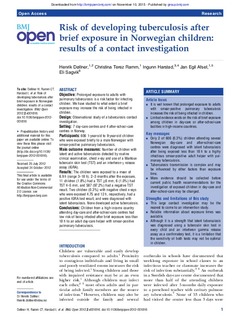Risk of developing tuberculosis after brief exposure in Norwegian children: results of a contact investigation
Journal article, Peer reviewed
Permanent lenke
http://hdl.handle.net/11250/2365150Utgivelsesdato
2012Metadata
Vis full innførselSamlinger
Sammendrag
Objective: Prolonged exposure to adults with pulmonary tuberculosis is a risk factor for infecting children. We have studied to what extent a brief exposure may increase the risk of being infected in children.
Design: Observational study of a tuberculosis contact investigation.
Setting: 7 day-care centres and 4 after-school-care centres in Norway.
Participants: 606 1-year-old to 9-year-old children who were exposed briefly to a male Norwegian with smear-positive pulmonary tuberculosis.
Main outcome measures: Number of children with latent and active tuberculosis detected by routine clinical examination, chest x-ray and use of a Mantoux tuberculin skin test (TST) and an interferon-γ release assay (IGRA).
Results: The children were exposed to a mean of 6.9 h (range 3–18 h). 2–3 months after the exposure, 11 children (1.8%) had a TST ≥6 mm, 6 (1.0%) had TST 4–5 mm, and 587 (97.2%) had a negative TST result. Two children (0.3%) with negative chest x-rays who were exposed 4.75 and 12 h, respectively, had a positive IGRA test result, and were diagnosed with latent tuberculosis. None developed active tuberculosis.
Conclusions: Children from a high-income country attending day-care and after-school-care centres had low risk of being infected after brief exposure less than 18 h to an adult day-care helper with smear-positive pulmonary tuberculosis.
